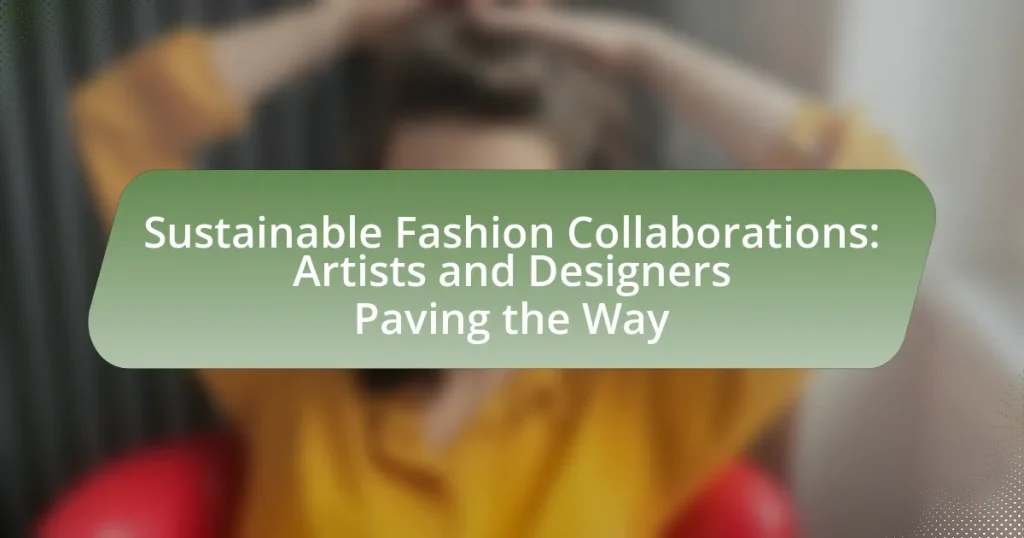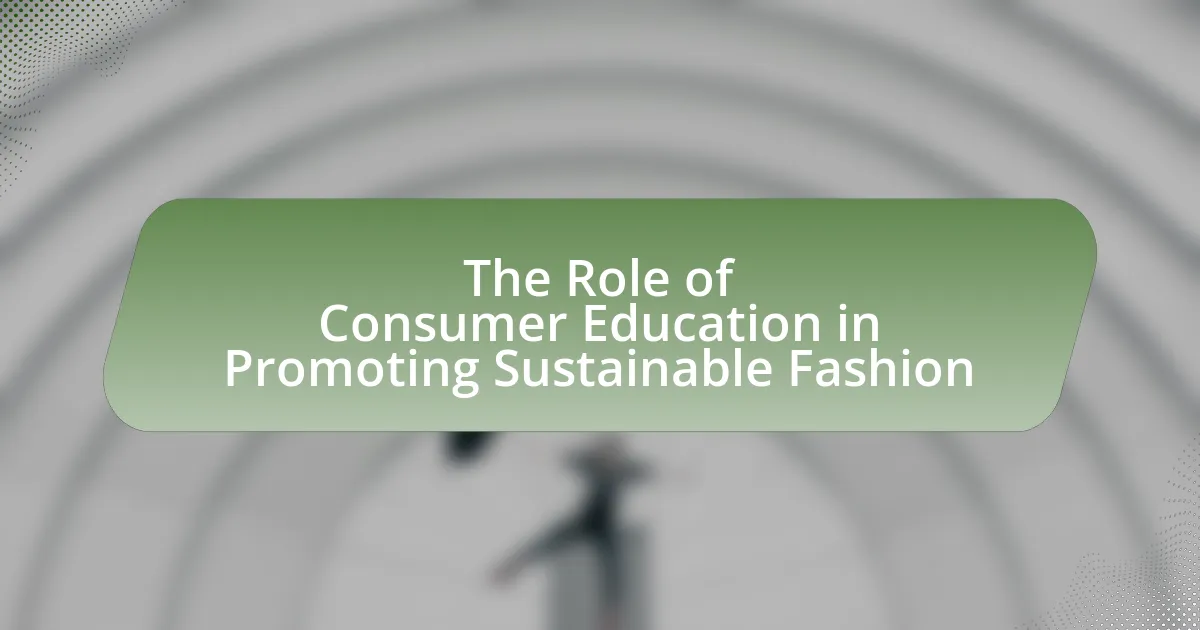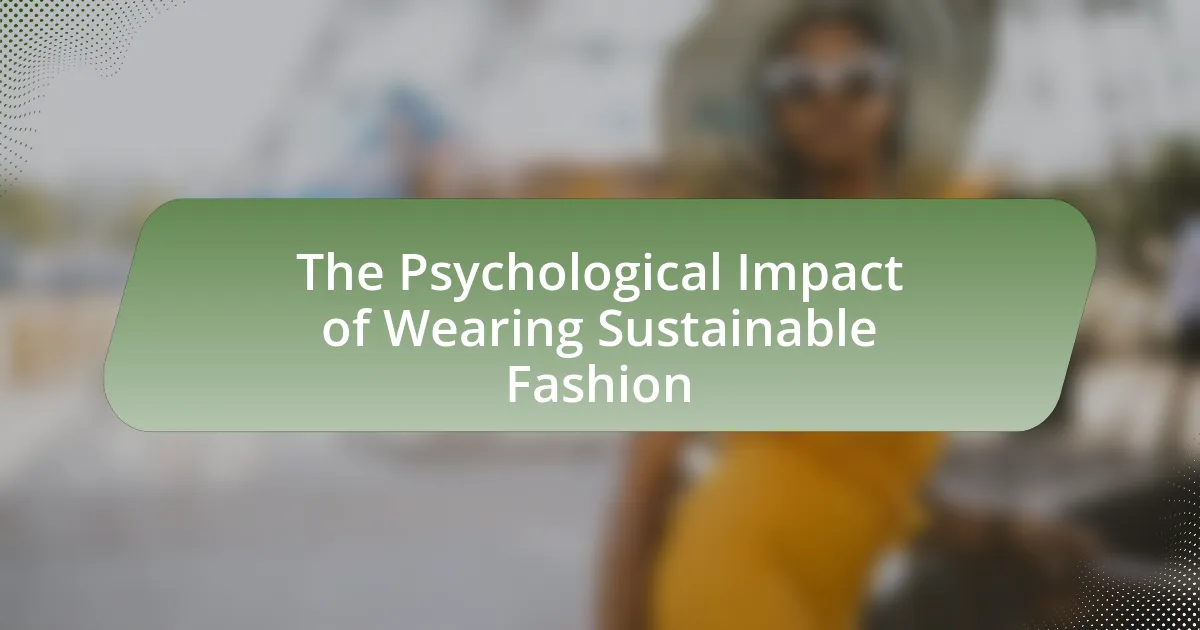Sustainable fashion collaborations involve partnerships between designers, brands, and artists aimed at creating environmentally friendly and socially responsible clothing and accessories. These collaborations prioritize the use of sustainable materials, ethical production practices, and innovative design techniques to mitigate the fashion industry’s environmental impact. Key contributions from artists and designers include the integration of eco-friendly fabrics and upcycling methods, which enhance both the aesthetic value and awareness of sustainability in fashion. Notable examples include collaborations between Stella McCartney and Adidas, as well as H&M’s Conscious Exclusive collection, showcasing the effectiveness of these partnerships in promoting circular fashion principles and influencing consumer behavior towards more responsible purchasing decisions.
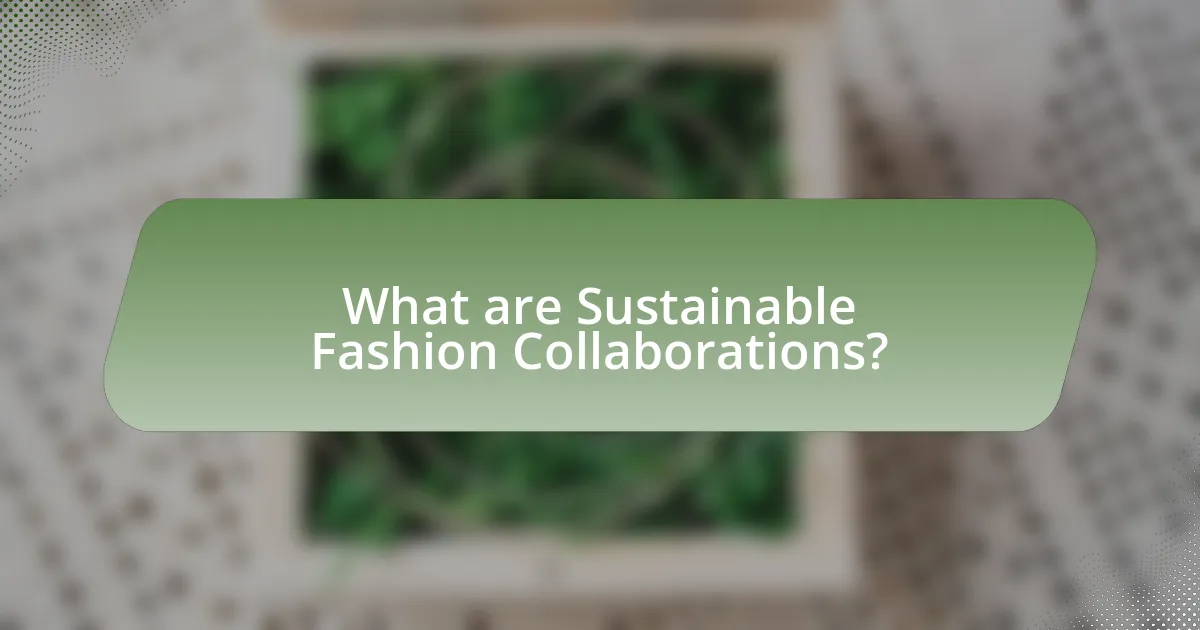
What are Sustainable Fashion Collaborations?
Sustainable fashion collaborations are partnerships between designers, brands, and artists aimed at creating environmentally friendly and socially responsible clothing and accessories. These collaborations often focus on using sustainable materials, ethical production practices, and innovative design techniques to reduce the fashion industry’s environmental impact. For instance, brands like Stella McCartney have collaborated with organizations such as the Ellen MacArthur Foundation to promote circular fashion principles, demonstrating the effectiveness of these partnerships in advancing sustainability in the industry.
How do artists and designers contribute to sustainable fashion collaborations?
Artists and designers contribute to sustainable fashion collaborations by integrating innovative materials and ethical practices into their work. They often prioritize the use of eco-friendly fabrics, such as organic cotton or recycled materials, which reduces environmental impact. For instance, collaborations like Stella McCartney’s partnership with Adidas focus on sustainable production methods, showcasing how high fashion can align with ecological responsibility. Additionally, artists bring unique perspectives that challenge conventional fashion norms, promoting circularity and upcycling, as seen in projects like the “Fashion for Good” initiative, which encourages creative solutions to waste in the industry. These contributions not only enhance the aesthetic value of sustainable fashion but also raise awareness about environmental issues, driving consumer demand for responsible practices.
What roles do artists play in promoting sustainability in fashion?
Artists play a crucial role in promoting sustainability in fashion by using their creativity to raise awareness and inspire change. They often collaborate with designers to create eco-friendly collections that emphasize the importance of sustainable materials and ethical production practices. For instance, artists like Stella McCartney incorporate innovative designs that utilize organic fabrics and recycled materials, showcasing how fashion can be both stylish and sustainable. Additionally, artists engage in campaigns and exhibitions that highlight the environmental impact of fast fashion, effectively educating consumers and encouraging them to make more conscious choices. This multifaceted approach not only influences industry standards but also fosters a cultural shift towards sustainability in fashion.
How do designers integrate sustainable practices into their collaborations?
Designers integrate sustainable practices into their collaborations by prioritizing eco-friendly materials, ethical production methods, and circular design principles. For instance, they often select organic or recycled fabrics to minimize environmental impact and work with manufacturers that adhere to fair labor practices. Additionally, designers may implement strategies such as upcycling existing materials or creating designs that encourage longevity and recyclability, thereby reducing waste. Research indicates that collaborations focusing on sustainability can lead to a 30% reduction in carbon emissions compared to traditional practices, highlighting the effectiveness of these integrated approaches.
Why are sustainable fashion collaborations important?
Sustainable fashion collaborations are important because they combine resources and expertise from various stakeholders to create environmentally friendly products. These partnerships often lead to innovative designs that prioritize sustainability, reducing waste and promoting ethical practices in the fashion industry. For instance, collaborations between established brands and eco-conscious designers have resulted in collections that utilize recycled materials, significantly lowering the carbon footprint associated with production. According to a report by McKinsey & Company, the fashion industry is responsible for 10% of global carbon emissions, highlighting the urgent need for collaborative efforts to mitigate environmental impact.
What environmental impacts do these collaborations aim to address?
These collaborations aim to address several environmental impacts, primarily focusing on reducing waste, minimizing carbon emissions, and promoting sustainable resource use in the fashion industry. By utilizing eco-friendly materials and innovative design practices, these partnerships work to decrease the overall environmental footprint of clothing production. For instance, a report by the Ellen MacArthur Foundation highlights that the fashion industry is responsible for 10% of global carbon emissions and significant textile waste, underscoring the urgency for sustainable practices.
How do sustainable collaborations influence consumer behavior?
Sustainable collaborations significantly influence consumer behavior by enhancing brand trust and loyalty. When brands partner with environmentally conscious organizations or artists, they signal a commitment to sustainability, which resonates with consumers increasingly prioritizing ethical practices. Research indicates that 66% of global consumers are willing to pay more for sustainable brands, demonstrating a direct correlation between sustainable collaborations and purchasing decisions. Furthermore, these partnerships often lead to innovative products that appeal to eco-conscious consumers, reinforcing their preference for brands that align with their values.
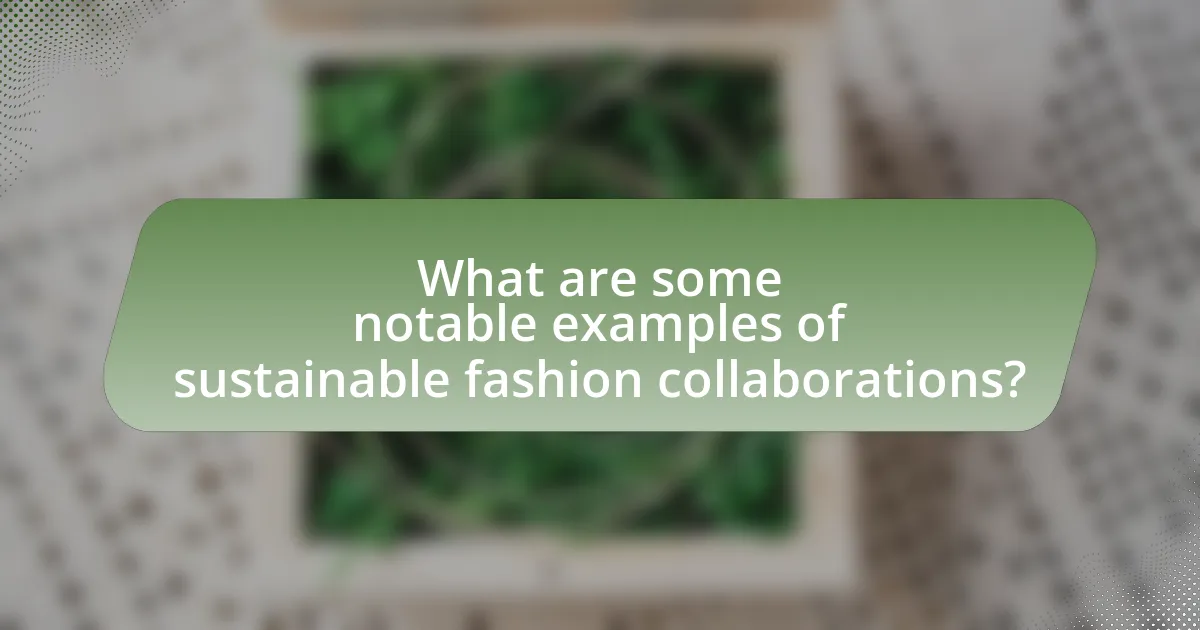
What are some notable examples of sustainable fashion collaborations?
Notable examples of sustainable fashion collaborations include the partnership between Stella McCartney and Adidas, which focuses on eco-friendly materials and ethical production practices. Another significant collaboration is between H&M and the Conscious Exclusive collection, which utilizes sustainable fabrics like organic cotton and recycled polyester. Additionally, the collaboration between Gucci and The North Face emphasizes circular fashion through the use of recycled materials and a commitment to reducing environmental impact. These collaborations demonstrate a commitment to sustainability in the fashion industry, showcasing innovative approaches to design and production.
Which artists have made significant contributions to sustainable fashion?
Stella McCartney has made significant contributions to sustainable fashion through her commitment to eco-friendly practices and materials. As a pioneer in the industry, she has consistently advocated for the use of organic cotton, recycled polyester, and innovative materials like vegan leather, which align with sustainable principles. McCartney’s brand is known for its transparency and ethical production processes, setting a benchmark for other designers. Additionally, she has collaborated with various organizations to promote sustainability, further solidifying her impact on the fashion industry.
What unique approaches have these artists taken in their collaborations?
Artists in sustainable fashion collaborations have employed unique approaches such as integrating upcycled materials, utilizing local artisans, and emphasizing storytelling through their designs. For instance, some artists have transformed discarded textiles into high-fashion pieces, showcasing the potential of waste reduction while maintaining aesthetic appeal. Additionally, collaborations often involve partnerships with local craftspeople, which not only supports community economies but also preserves traditional techniques. Furthermore, artists frequently incorporate narratives about sustainability into their collections, enhancing consumer awareness and engagement with environmental issues. These methods collectively highlight a commitment to sustainability while fostering innovation in the fashion industry.
How have these collaborations impacted the fashion industry?
Collaborations between artists and designers have significantly transformed the fashion industry by promoting sustainability and innovative practices. These partnerships often merge artistic vision with eco-friendly materials and ethical production methods, leading to a shift in consumer awareness and demand for sustainable fashion. For instance, collaborations like Stella McCartney with various artists have highlighted the importance of using organic materials and reducing waste, influencing other brands to adopt similar practices. This trend is supported by a 2021 McKinsey report, which indicated that 67% of consumers consider sustainability when making fashion purchases, showcasing the growing impact of these collaborations on consumer behavior and industry standards.
What designers are leading the way in sustainable fashion collaborations?
Stella McCartney and Gabriela Hearst are leading designers in sustainable fashion collaborations. Stella McCartney has been a pioneer in eco-friendly fashion since 2001, utilizing sustainable materials and ethical practices in her collections. Gabriela Hearst, known for her commitment to sustainability, incorporates recycled materials and promotes transparency in her supply chain. Both designers have collaborated with various brands and organizations to further the cause of sustainable fashion, demonstrating their influence and commitment to environmental responsibility in the industry.
What innovative techniques are these designers using?
Designers in sustainable fashion are utilizing techniques such as upcycling, zero-waste pattern making, and the use of biodegradable materials. Upcycling involves transforming discarded materials into new products, thereby reducing waste and promoting resourcefulness. Zero-waste pattern making focuses on creating garments without leftover fabric, which minimizes textile waste during production. Additionally, the adoption of biodegradable materials, such as organic cotton and Tencel, ensures that products decompose naturally at the end of their lifecycle, further contributing to environmental sustainability. These techniques collectively reflect a commitment to reducing the ecological footprint of fashion.
How do these designers measure the success of their collaborations?
Designers measure the success of their collaborations through various metrics, including sales performance, audience engagement, and sustainability impact. For instance, they analyze sales data to determine the financial success of the collaboration, while also assessing social media engagement and customer feedback to gauge public reception. Additionally, designers evaluate the environmental benefits achieved through sustainable practices, such as reduced waste or lower carbon emissions, which can be quantified through lifecycle assessments. These metrics provide a comprehensive view of the collaboration’s effectiveness in both commercial and ecological terms.
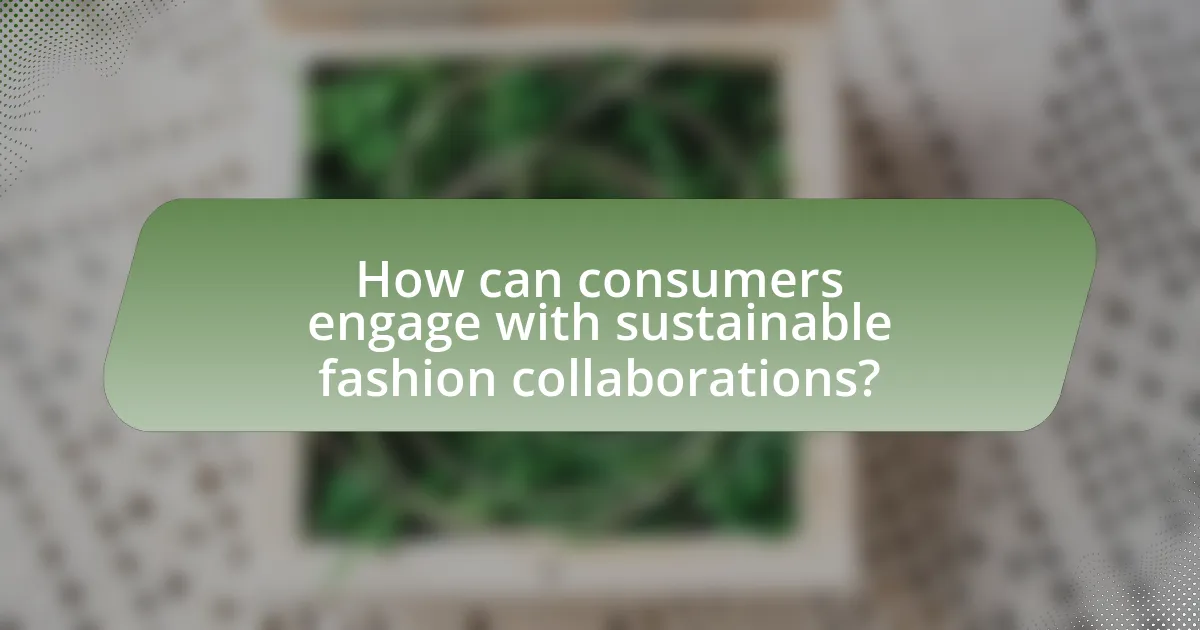
How can consumers engage with sustainable fashion collaborations?
Consumers can engage with sustainable fashion collaborations by actively participating in purchasing products from these initiatives. By choosing to buy items created through collaborations between brands and artists focused on sustainability, consumers support eco-friendly practices and innovative designs. For instance, collaborations like Stella McCartney’s partnership with Adidas emphasize sustainable materials and ethical production methods, showcasing how consumer purchases can drive demand for responsible fashion. Additionally, consumers can follow these collaborations on social media, attend pop-up events, and provide feedback, further fostering a community around sustainable fashion.
What are the best practices for supporting sustainable fashion initiatives?
The best practices for supporting sustainable fashion initiatives include prioritizing ethical sourcing, promoting circular fashion, and fostering transparency in supply chains. Ethical sourcing ensures that materials are obtained from sustainable sources, reducing environmental impact and supporting fair labor practices. Circular fashion encourages the design of products that can be reused, repaired, or recycled, thus minimizing waste. Transparency in supply chains allows consumers to make informed choices, as they can verify the sustainability claims of brands. According to a 2021 report by the Ellen MacArthur Foundation, transitioning to a circular economy in fashion could reduce global carbon emissions by 44% by 2030, highlighting the importance of these practices.
How can consumers identify truly sustainable collaborations?
Consumers can identify truly sustainable collaborations by examining the transparency of the brands involved, their sourcing practices, and their commitment to ethical labor standards. Brands that provide detailed information about their supply chains, including the origins of materials and the conditions under which products are made, demonstrate a higher level of accountability. For instance, certifications such as Fair Trade, GOTS (Global Organic Textile Standard), and B Corp can serve as indicators of a brand’s commitment to sustainability. Additionally, consumers should look for collaborations that prioritize eco-friendly materials, such as organic cotton or recycled fabrics, and those that actively engage in reducing waste through circular fashion initiatives.
What role does consumer education play in promoting sustainable fashion?
Consumer education plays a crucial role in promoting sustainable fashion by informing individuals about the environmental and social impacts of their clothing choices. Educated consumers are more likely to prioritize sustainable brands, which often use eco-friendly materials and ethical labor practices. For instance, a study by the Global Fashion Agenda found that 66% of consumers are willing to pay more for sustainable fashion, indicating that knowledge about sustainability influences purchasing behavior. By raising awareness of issues such as textile waste and the carbon footprint of fast fashion, consumer education empowers individuals to make informed decisions that support sustainable practices in the fashion industry.
What future trends can we expect in sustainable fashion collaborations?
Future trends in sustainable fashion collaborations will increasingly focus on circular economy principles, where brands and designers prioritize recycling and upcycling materials to minimize waste. Collaborations will likely involve partnerships between fashion brands and technology companies to develop innovative, sustainable materials, such as bio-fabricated textiles. Additionally, there will be a rise in co-creation initiatives that engage consumers in the design process, fostering a sense of community and shared responsibility for sustainability. Evidence of this trend can be seen in initiatives like the Ellen MacArthur Foundation’s Circular Fibres Initiative, which promotes collaboration among industry stakeholders to create a circular fashion economy.
How might technology influence future collaborations in sustainable fashion?
Technology will significantly enhance future collaborations in sustainable fashion by facilitating real-time communication, data sharing, and innovative design processes. Advanced tools such as blockchain can ensure transparency in supply chains, allowing designers and brands to verify the sustainability of materials and practices. Additionally, virtual reality and augmented reality can enable immersive design experiences, fostering collaboration between artists and designers across geographical boundaries. For instance, a study by McKinsey & Company highlights that digital tools can reduce the time to market for sustainable products by up to 30%, demonstrating the efficiency gains technology brings to collaborative efforts in this sector.
What emerging artists and designers should we watch in this space?
Emerging artists and designers to watch in sustainable fashion include Marine Serre, known for her innovative use of upcycled materials, and Telfar Clemens, who emphasizes inclusivity and accessibility in his designs. Marine Serre’s collections often feature recycled textiles, showcasing a commitment to sustainability while maintaining high fashion standards. Telfar’s brand, Telfar, has gained recognition for its gender-neutral approach and the “Bushwick Birkin” bag, which has become a symbol of accessible luxury. Both artists are leading the charge in redefining fashion through sustainable practices and social consciousness.
What practical steps can individuals take to support sustainable fashion collaborations?
Individuals can support sustainable fashion collaborations by actively choosing to purchase from brands that prioritize eco-friendly practices and ethical production. By selecting clothing made from sustainable materials, such as organic cotton or recycled fabrics, consumers directly contribute to reducing environmental impact. Additionally, individuals can participate in clothing swaps or second-hand shopping, which promotes circular fashion and minimizes waste. Supporting local artisans and designers who focus on sustainable methods further strengthens these collaborations. Research indicates that the global sustainable fashion market is projected to reach $8.25 billion by 2023, highlighting the growing consumer demand for responsible fashion choices.
